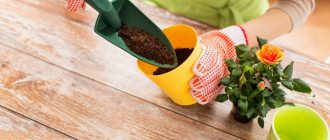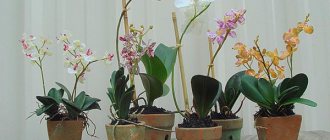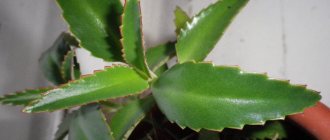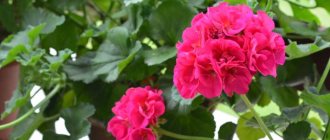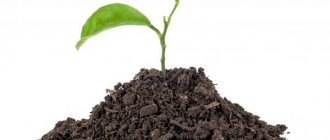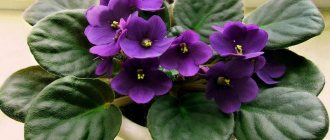Many of us delight ourselves and our loved ones with the presence of indoor flowers in our house or apartment. Kalanchoe is one of the most common plants purchased at home. It does not require frequent watering, is unpretentious, grows quite intensively, reproduces well and pleases the eye with magnificent colorful flowers. Kalanchoe is also a medicinal plant, whose medicinal properties have been known since ancient times. This wonderful flower has healing and bactericidal properties. Even a novice gardener can grow Kalanchoe; any well-lit window sill is suitable for growing it.
When to replant Kalanchoe
The first transplant for Kalanchoe is very significant. How it will take root in your home and its ability to flower depends on this. The young Kalanchoe flower, undemanding in care, initially needs to be replanted every spring. This is due to the fact that the plant grows very rapidly. The main thing is to replant in the spring and not at the time of flowering. An adult flower is replanted every 2-3 years. Even a beginner can determine when it’s time to replant a flower. To do this, you need to pay attention to the color of the leaves: it should not lose saturation. Also check the location of the roots in the flower pot: they should not be crowded and the roots should be firmly in the ground. And of course the soil must absorb moisture well. If the plant is not replanted in time, it will not receive enough moisture and nutrients, it will suffer in cramped conditions, which will affect development and flowering.
Reasons why Kalanchoe needs replanting
The medicinal properties of Kalanchoe have been known since ancient times, and its ability to reproduce is hardly comparable to any other plant. Extremely unpretentious, adaptable to any conditions, both in the sun and in the shade. As a succulent, it prefers well-lit places and poor soil. The reasons why it is transplanted more often than others are its intensive growth and rapidity of spread.
Young plants bordering the leaves fall to the soil and are guaranteed to take root. If you do not plant them, then after a while a “plantation” of Kalanchoe will form in the pot.
Species grown in indoor floriculture:
- Dergemona,
- Cirrus,
- Kalandiva,
- Blossfeld,
- Laciniata,
- Beharskoe,
- Felt,
- Tubeflower
Tip #1. When a bush grows too densely, it must be thinned out, otherwise the excessive green mass will not allow the plant to bloom.
Replanting after purchase
After purchasing a flower, the first thing to do is replant the plant. Replanting is required to change the peat soil, which is most often used in stores. It is completely unacceptable for the existence and development of the plant. If a flower is purchased during the flowering period, it is very undesirable to replant it. You will have to wait some time until the flower fades, although it is not recommended to leave it in the soil in which it was purchased. The transplantation process itself is not complicated, however, and there are a number of rules and recommendations, which, if violated, can harm the plant, despite its vitality. Inspect the flower for the thickness and color of the leaves. The leaves should not be thinned, pale or yellowed. This may indicate a disease or the presence of pests. If something seems suspicious to you, wait a couple of days before replanting and observe the plant. The optimal time to buy a flower is spring.
Preparatory work
Before transplanting the plant, it is necessary to carry out a number of preparatory work. Prepare a substrate, some sand, drainage and water. Select the size of the pot into which the flower will be transplanted. If the pot has been used, be sure to wash it with laundry soap and disinfect it with a solution of manganese or a 2% solution of copper sulfate for a couple of hours. Wash the new container with soap and keep in boiling water for two hours. Use only when the container is completely dry so that the root structure of the plant does not begin to rot.
How to choose the right pot for transplanting
When choosing containers for transplantation, parameters and material are taken into account. The size of the pot for young Kalanchoe is usually from 12 to 18 cm in diameter. When replanting a young plant, choose a container 2-3 cm wider than the previous one; when replanting an adult Kalanchoe, the old one should fit into the new pot, not too tightly, but not too loosely. If you take a wider pot, then the plant will not form flower buds, but the leaves will only grow larger. We choose the material for the pot taking into account Kalanchoe’s love for moisture. It must withstand changes in humidity and have high porosity so that the root system can breathe. Plastic pots, although they meet one of the requirements, still do not need to be used for this plant. It is better to give preference to a glazed clay pot. You should not choose a too beautiful, decorative pot, choose the most ordinary one. Soon the sides and bottom of the pot will be covered with salt and water stains, especially if the watering is in a tray. When purchasing a new pot, pay attention that it has no sharp edges, cracks or chips. It is better to choose a tray with a larger diameter for more convenient watering.
Propagation by cuttings
The best way to propagate Kalanchoe is to use its cuttings. To do this, after flowering is complete, you need to carefully trim one branch of the plant with garden shears. Then you should remove all existing leaves 5 cm from its base and leave the resulting cutting to dry in the open air for 3 days. During the drying process, the formation of a so-called callus occurs at the site where the cutting is cut.
After 3 days, the cuttings should be planted in the ground in a pot. To do this, it is necessary to prepare this soil; it is recommended to use a mixture consisting of 60% peat and 40% perlite as a substrate, which provides good drainage conditions for planting. It is recommended to use a clay flower pot as it allows air to pass through well.
The planting process is simple: you need to make a hole in the substrate with a pen or pencil and place a dry cutting in it. Some gardeners, before planting in the ground, dip the cuttings into a mixture that stimulates the development of the root system.
Once the small plant is in the pot, lightly water it and then place a clear plastic bag over the pot to help maintain a humid atmosphere. After these measures, the pot must be placed in a well-lit place and the condition of the soil should be checked from time to time and watered if it is dry.
Kalanchoe cuttings begin to take root 2-3 weeks after they are planted in the ground. After this time, the plastic bag can be removed from the pot and the flower can be cared for as an adult plant. Below is an example of transplantation steps in the photo. Kalanchoe flowers require simple care at home.
Soil and drainage for Kalanchoe
Kalanchoe requires good drainage, otherwise the flower may die from excess moisture and stagnation of liquid. Therefore, first of all, it is laid out on the bottom of the pot. This could be expanded clay, broken pieces of clay shards or gravel. Approximately 20-25% of the pot's volume should be filled, since the plant's roots do not tolerate flooding after watering.
Soil can be purchased at a specialty store. This is a soil for succulents or a universal soil for succulents and cacti. Or you can make the soil yourself, it’s better and healthier. It consists of two parts. The first part is two parts of turf land. The second part is mixed one part of leaf soil and half of river sand and peat. You definitely need to steam or warm the soil in the oven so as not to infect your plant with fungal infections and pests. To achieve the desired acidity of the soil, you can add a mixture of brick chips and crushed coal. If this is not the first transplant for your flower, try to use the same composition of the substrate in which you had it before. This is done to make it easier for Kalanchoe to take root in a new place. After all, for a plant, any transplant, even the most gentle one, is stressful.
Transplantation process
We place drainage at the bottom of the selected pot and a little sand on top. Pour in some of the prepared soil mixture, moisten it (preferably several hours before replanting), but do not overwater it. The mixture should be slightly moist. We compact the soil a little and create a small bump in the center of the pot to accommodate the root system. The day before, thoroughly water the soil in the pot with the plant so that on the day of replanting you can easily get the flower out and not damage the roots. Carefully remove the plant. To do this, turn the container over and, tapping on the walls, free it from the ground. We carefully separate the roots from the old soil, gently hitting them with a stick. Do not rinse in water; the roots must be dry. We carefully examine the condition of the root system. If there are unhealthy, damaged or rotten pieces, be sure to remove them. Place the treated flower in a pot, distribute the roots evenly over the tubercle and fill the remaining free space with soil, lightly compacting the soil. The soil layer should be approximately 2-3 cm below the top edge of the pot. We hold the plant a little so that it is located in the center. After this, carefully water it and, if necessary, add more substrate.
Comparative analysis of fertilizers required during transplantation, all the pros and cons
In addition to baking powder, fertilizers are added to the soil for Kalanchoe for better survival of the root system. The exposed root system is treated with growth stimulants. The following means are usually used:
| Purpose | Name | Peculiarities | Flaws |
| Rooter | Kornevin | Sold in powder or gel form. Before planting, dust the cuttings or exposed roots or dip them in gel. During transshipment, the solution is applied to the periphery of the coma, which is where young roots grow. | Dosage rules must be strictly followed. |
| Heteroauxin | |||
| succinic acid |
Tip #2. Exceeding the stimulant norm can lead to the opposite result, slower growth and even death of the plant.
For decorative deciduous species, fertilizers with a high nitrogen content are used, and for flowering species, phosphorus and potassium are needed. This differs in the selection of products for different Kalanchoes. After transplantation, when new leaves appear, the plant can be supported with fertilizers for cacti and succulents.
- "Etisso" contains nitrogen - 3.8%, phosphorus - 7.6%, potassium - 7.5% and trace elements. Well suited for flowering Kalanchoes.
The peculiarity of the use of fertilizers for Kalanchoe is seasonality. Apply from April to September; discard during the cold season.
- " Pokkon " is formulated for the full growth and flowering of succulents. Feeding is carried out from spring to autumn. Available in liquid form.
- In addition to minerals, “Good Power” It differs from other drugs in its long shelf life. Retains beneficial properties even after defrosting.
Step-by-step instructions for replanting Kalanchoe:
| Stage | Description |
| Step 1. | Select a pot of the required size. |
| Step 2. | Pour drainage (expanded clay or small pebbles) onto the bottom in a layer of 2 cm. |
| Step 3. | Prepare a substrate from turf soil, sand, humus in equal parts. You can add baking powder in the form of perlite, etc. to the mixture. |
| Step 4. | Pour some of the mixture into the pot. |
| Step 5. | Place the plant in the center so that the root collar is located at a depth of 2 cm from the edge of the pot. |
| Step 6. | Sprinkle the substrate along the walls of the pot, carefully compacting it. |
| Step 7 | After transplantation, the plant is watered so that water appears in the pan. The excess is poured out. |
Principles of care after transplantation
After transplanting the Kalanchoe, we place it in a sunny place, the best option is the southwest or southeast side. Before the end of the adaptation period in a new place, the flower may wilt and even fall off its leaves, so it is necessary to shade the plant so that direct rays of the sun do not fall on it. Water generously, but without excess. There should be no swamp in the pot. The plant gets used to the fresh substrate within a week or two. We carry out a small fertilizing with mineral fertilizers. They can be found at any flower shop. In the future, after 7-10 days, water the flower in the same way as before transplantation as the soil dries. We gradually resume normal care, and now Kalanchoe pleases you with its magnificent flowering.
Possible problems associated with transplantation
- If you are not careful when replanting a plant, you can damage the fragile leaves and stems, which will affect the survival rate.
- The plant may not take root if it is not replanted in the spring, so it is better to buy a flower in the spring months in order to be able to replant it without consequences.
- The plant may not bloom for a long time after transplantation; in this case, it is necessary to reduce feeding to once a month. It may also be that you chose a pot that is too large.
- Choosing the wrong location for a plant can lead to wilting. Yellowed upper leaves indicate a lack of light. And if both the upper and lower leaves turn yellow, this indicates excessive lighting.
- Also, leaves may wither if the roots are damaged during transplantation. In this case, you need to give the flower time to take root in the new place and reduce watering.
- In the absence or inhibition of growth, you need to add fertilizing, the plant does not have enough nutrients. The soil may also be selected incorrectly. In this case, you need to replant, taking into account all the requirements for the soil mixture.
Category: “Questions and answers”
Question No. 1. By what signs can you determine what is missing in the soil substrate?
If the color of the leaves turns pale and the plant looks depressed, this is the result of watering with hard water. It is best to water Kalanchoe with rain or melt water. If this is not possible, then it is better to use settled water. Apply fertilizer to cacti and succulents every month. Before flowering, you can apply fertilizer for flowering indoor plants containing phosphorus and potassium.
Question No. 2. How many flowers can you plant in one pot?
Usually no more than three are planted. At the same time, you need to take into account that they will have to be transplanted earlier than if they grew alone.
Question No. 3. Is it possible to plant Kalanchoe outdoors for the summer?
Yes, if you choose a cozy place with light shade and loose soil. Excessive fertility is not needed; it is better to add coarse sand or fine expanded clay.
